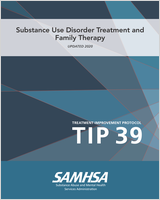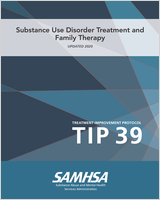NCBI Bookshelf. A service of the National Library of Medicine, National Institutes of Health.
This publication is provided for historical reference only and the information may be out of date.
This TIP, Substance Abuse Treatment and Family Therapy, addresses how substance abuse affects the entire family and how substance abuse treatment providers can use principles from family therapy to change the interactions among family members. The TIP provides basic information about family therapy for substance abuse treatment professionals and basic information about substance abuse treatment for family therapists. The TIP presents the models, techniques and principles of family therapy, with special attention to the stages of motivation as well as to treatment and recovery. Discussion also focuses on clinical decisionmaking and training, supervision, cultural considerations, specific populations, funding and research. The TIP further identifies future directions for both research and clinical practice.
Contents
- Acknowledgments
- What Is a TIP?
- Consensus Panel
- KAP Expert Panel and Federal Government Participants
- Foreword
- Executive Summary
- Chapter 1 Substance Abuse Treatment and Family Therapy
- Chapter 2 Impact of Substance Abuse on Families
- Chapter 3 Approaches to Therapy
- Chapter 4 Integrated Models for Treating Family Members
- Chapter 5 Specific Populations
- Chapter 6 Policy and Program Issues
- Appendix A: Bibliography
- Appendix B: Glossary
- Appendix C: Guidelines for Assessing Violence
- Appendix D: Resources
- Appendix E: Resource Panel
- Appendix F: Cultural Competency and Diversity Network Participants
- Appendix G: Field Reviewers
Suggested citation:
Center for Substance Abuse Treatment. Substance Abuse Treatment and Family Therapy. Treatment Improvement Protocol (TIP) Series, No. 39. DHHS Publication No. (SMA) 04‐3957. Rockville, MD: Substance Abuse and Mental Health Services Administration, 2004.
The opinions expressed herein are the views of the consensus panel members and do not necessarily reflect the official position of CSAT, SAMHSA, or DHHS. No official support of or endorsement by CSAT, SAMHSA, or DHHS for these opinions or for particular instruments, software, or resources described in this document are intended or should be inferred. The guidelines in this document should not be considered substitutes for individualized client care and treatment decisions.
- Review Brief Interventions and Brief Therapies for Substance Abuse[ 1999]Review Brief Interventions and Brief Therapies for Substance AbuseCenter for Substance Abuse Treatment. 1999
- Critical issues in the development of culturally relevant substance abuse treatments for specific minority groups.[Alcohol Clin Exp Res. 2003]Critical issues in the development of culturally relevant substance abuse treatments for specific minority groups.Gonzàlez Castro F, Garfinkle J. Alcohol Clin Exp Res. 2003 Aug; 27(8):1381-8.
- Review Addressing the Specific Behavioral Health Needs of Men[ 2013]Review Addressing the Specific Behavioral Health Needs of MenCenter for Substance Abuse Treatment (US). 2013
- Review Simple Screening Instruments for Outreach for Alcohol and Other Drug Abuse and Infectious Diseases[ 1994]Review Simple Screening Instruments for Outreach for Alcohol and Other Drug Abuse and Infectious DiseasesCenter for Substance Abuse Treatment. 1994
- Review Substance Abuse Among Older Adults[ 1998]Review Substance Abuse Among Older AdultsCenter for Substance Abuse Treatment. 1998
- Substance Abuse Treatment and Family TherapySubstance Abuse Treatment and Family Therapy
Your browsing activity is empty.
Activity recording is turned off.
See more...

